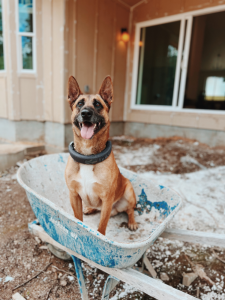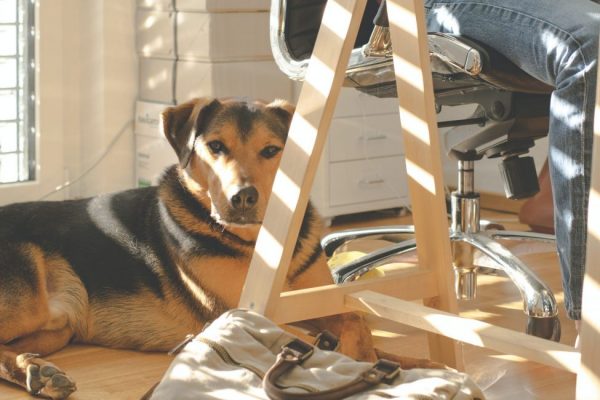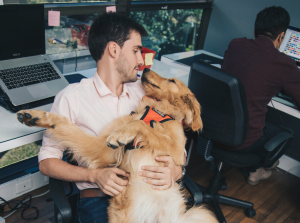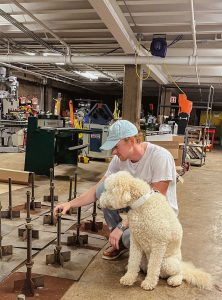The COVID-19 pandemic had a significant impact on the work/life balance of employees worldwide. This impact was amplified in families with dogs. After a year-plus of most dog owners working from home, many are now returning to in-person work post-COVID. This phenomenon may result in dog separation anxiety. Let’s explore that issue, and whether or not taking dogs to work with you is the best solution.
 What is dog separation anxiety?
What is dog separation anxiety?
Separation anxiety is traditionally understood as a fear or uneasiness that a child feels when away from his or her parents. When the parent/child separation occurs, the child cannot think about anything but their present fear of separation.
As our society learns more about dog psychology, we are understanding that the same feelings occur in some dogs when separated from their owner.
Since the onset of COVID-19 around March 2020, most workers have spent at least some amount of time working from home. As a result, many dogs have become accustomed to spending all day with their owners.
Now, some companies are requiring a partial (if not full) return to in-office work. As a result, the conditions are ripe for dogs to be distressed by their owners’ newfound schedules.
So how do you know if your dog is experiencing separation anxiety?
What to look for
Often, dogs who are left alone exhibit a variety of problem behaviors. This can even occur in otherwise well-behaved pups. Many owners will simply chalk this behavior up to “dogs being dogs,” or think that perhaps they didn’t train their pup well enough.
The reality is that your dog may be trained perfectly well, but they still feel anxious when you leave them. These behaviors could be a manifestation of that anxiety.
Here are some signs you should look for that suggest your dog may be experiencing separation anxiety. Note that a key component of this behavior is that it only occurs when you and your dog are separated. If your dog exhibits these behaviors when you are present, then it likely is not due to separation anxiety.
Signs of dog separation anxiety
- They change their behavior when you are preparing to leave the house.
Your pup can tell when you are getting ready to leave. They may become agitated, depressed, or anxious when they notice that you’ll be leaving soon. This anxiety may manifest as barking, whining, drooling, chewing excessively, or attempting to stop you from leaving the house.
- They urinate/defecate in the house, but ONLY when you’re gone.
If your dog has a constant problem with going to the bathroom in the house, then that is not a sign of separation anxiety. However, if they only have ‘accidents’ in the house when left alone, then your dog likely experiences separation anxiety.
- Distressed barking and howling.
Another common sign of separation anxiety in dogs is that they will bark and howl constantly when separated from their owner. These vocalizations are an easy way for your dog to broadcast their distress. If the barking and howling appear to only be triggered by being left alone, then it is likely a case of dog separation anxiety.
- Chewing, digging, and destroying.
Some dogs with separation anxiety will relentlessly chew on household objects or attempt to escape through doors and windows when left alone. If your dog only exhibits these behaviors when separated from you, then separation anxiety is likely to blame.
- Pacing
Some anxious dogs will pace back and forth in a fixed pattern. Pacing is a sign of distress in many animals when they are confined, and dogs are no different. If your dog paces relentlessly when you leave them alone, then you should look into solutions for dog separation anxiety.
How to treat dog separation anxiety
If your dog experiences separation anxiety, you have a few different options to help them cope.
Counter-conditioning
As all Halo Pack members learn while going through Cesar Millan’s 21-day training program, dogs learn by association. When you are first introducing the Halo collar to your dog, you teach them to associate the collar with positive things. That way, they will not be scared to put the collar on.
A similar technique can be used to combat separation anxiety. If you can teach your dog to associate being alone with something positive, like delicious food, then their anxiety may dwindle.
Try this: Every time you leave the house, give your pup a puzzle toy with food they like inside. Potential options include peanut butter, cream cheese, or canned dog food and kibble. Smelling their favorite food will occupy their attention. This will prompt them to focus on ‘solving’ the puzzle and getting to the delicious treat. This activity’s benefit is twofold. Your dog will have their attention diverted from your departure, and they will begin to associate your departure with yummy food!
Make sure that you only give your dog access to these particular toys and foods when you are leaving them. That way, they only associate these positive things with being alone.
If the counter-conditioning described above is insufficient for calming your dog, you may need to consider bringing your dog to work with you.
Should I bring my dog to work with me?
In addition to many workplaces embracing ‘hybrid’ work-from-home schedules, attitudes surrounding workplace etiquette are also changing. In an effort to be more casual and employee-friendly, some forward-thinking employers have begun to allow taking dogs to work.
For dog owners whose pups may be prone to separation anxiety, taking dogs to work could be the ideal solution. However, there are factors that you need to consider before deciding if you can bring your dog to work.
Pros of taking dogs to work
Stress relief. A 2012 study reported that employees with their dogs present showed lower stress levels as the workday went on. Being able to take a dog-petting break could do wonders for your mental health during a long workday. Not only that – if your dog has separation anxiety, then being in the office with you will provide them with stress relief too!
Bond with coworkers. Most people love dogs. Many people have at least one dog of their own. Bringing your pup into the office will give you and your coworkers a common point of interest to discuss. Often, work interactions are stuffy and formal, so this will give you and your coworkers something lighthearted to talk about.
Keeps your dog occupied. As we alluded to above, bringing your dog to the office can benefit them just as much as anyone else. If your pup is prone to separation anxiety, then coming to work with you is infinitely preferable to sitting alone at home all day. This gives you more opportunity to bond with your dog, and you don’t need to spend your day worrying about his or her well-being.
Cons of taking dogs to work
Co-workers with allergies or phobias. Not everyone loves dogs. Some people are scared of them. On the other hand, some people love dogs but cannot spend time around them because they will trigger an allergic reaction. If you want to bring your pup into the office, it’s important to consider your co-workers’ needs as well.
Disruptive to productivity. While having a dog in the office sounds ‘fun,’ dogs can also cause distractions. If your dog is often rowdy, loud, anxious, or high-maintenance, then they may cause distractions for yourself and your co-workers. Make sure you only take a dog into the office if they are well-behaved.
Your dog needs exercise. It’s great to be able to keep an eye on your dog, but dogs need a lot of exercise to stay happy and healthy. Sitting next to you in the office might help your with their separation anxiety. However, they may become just as anxious if they can’t run around. Make sure you have a plan for getting them exercise, like taking them out on a walk during your lunch break.
How to ask your employer to take your dog to work
If you decide you want to bring your dog to work, then you should ask your boss the right way. While some offices already have an open-door policy for their employees’ pups, other bosses may require a bit of convincing.
Here are a few tips for persuading your boss to allow you to bring your dog into the office:
Get your co-workers’ permission. If the people who you work with are on board with the idea, then that will alleviate many of your boss’ concerns.
Frame it as beneficial for the company. As we discussed before, taking dogs to work can help to reduce workers’ stress and increase the number of positive interactions between co-workers. An office with high collective morale is more likely to be productive too!
Test it out for a week. Ask your boss to allow one or two dogs in the office for one week to allow everyone to get a feel for it. If you can show your boss that morale and productivity will remain high, then you have a good chance of being told “Yes!”

Final thoughts on bringing dogs with separation anxiety into work
Owning a dog is a challenge. Owning a dog who suffers from separation anxiety adds a layer of complexity. As a loving owner, you want to do everything in your power to give your dog a comfortable life without sacrificing your productivity.
Taking dogs to work might not be right for everyone. However, many dog families could benefit from that option. It gives you and your dog more time to bond, and alleviates your dog’s fear of separation.
However, there is a possibility that you won’t be able to bring your furry best friend into the office. If that is the case, work with your pup to create positive associations with your departure from the house. That way, they will be almost as excited to see you leave as they will be to see you return.













